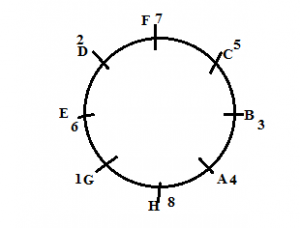Hello Aspirants. Welcome to Online Reasoning Section in AffairsCloud.com. We are providing Free IBPS Clerk course 2015 and creating sample questions in Reasoning, the type of which will be asked in IBPS Clerk Prelims Exam.
Stratus – IBPS Clerk Course 2015

[flipclock]
Directions (Q. 1-5): Study the following information to answer the given questions:
Eight students studying in different standards 1st, 2nd, 3rd, 4th, 5th, 6th, 7th and 8th namely – A, B, C, D, E, F, G, and H are seated around a circular table facing the centre.
C sits third to the rights of H. H studies in 8th. F sits second to the left of E. E is not an immediate neighbor of C or H. The one who studies in std. 1 is an immediate neighbor of E. Three people sit between H and the one studying in std. 7.
H, C and also their immediate neighbors do not study in std. 2. Only one person sits between the student of std. 2 and G. Students of std. 3 and 4 are immediate neighbors of each other. C is neither in std. 4 nor in std. 3. Only one person sits between A and the student of std. 5. A does not study in std. 2 or 3. B does not study in std. 2.
- Which of the following is true regarding F?
A) F studies in std. 5
B) D and G are immediate neighbors of F.
C) One person sits between F and the student of std. 4
D) F sits second to right of A.
E) None of theseE) None of these
Explanation:
- Who among the following studies in std. 3?
A) F
B) C
C) B
D) G
E) AC) B - Who among the following represents immediate neighbors of G?
A) A, B
B) E and the student of std. 2
C) H and the student of std. 6
D) A, D
E) E, FC) H and the student of std. 6 - Which of the following is true?
A) One person sits between H and the student of std. 2.
B) Only one person is sitting between student of std. 4 and std. 6.
C) The one studying in std. 3 is an immediate neighbor of H.
D) D studies in std. 2.
E) None is trueD) D studies in std. 2 - How many persons sit between D and the student of std. 4, when counted from the left hand side of student of std. 4?
A) None
B) One
C) Two
D) Three
E) FourD) Three
Directions (6 – 10): In these questions, relationship between different elements is shown in the statements. The statements are followed by conclusions. Give answers.
(A) only 1st follows
(B) only 2nd follows
(C) either 1st or 2nd
(D) neither 1st nor 2nd
(E) both 1st and 2nd
- Statements: A ≤ B < C; A ≥ D; C ≤ F
Conclusions:
I. D < C
II. D = C(A) only 1st follows
Explanation:
D ≤ A ≤ B < C so D < C
Since D < C is definite, so Answer will not be either or. - Statements: M ≥ S = Q < C, M ≤ T
Conclusions:
I. T > Q
II. T = Q(C) either 1st or 2nd
Explanation:
T ≥ M ≥ S = Q so T ≥ Q
T > Q or T = Q - Statements: K < L, K > M, M ≥ N, N > O
Conclusions:
I. O < M
II. O < K(E) both 1st and 2nd
Explanation:
O < N ≤ M < K so O < M and O < K - Statements: P < Q < R, R = S ≤ T
Conclusions:
I. Q > T
II. S > P(B) only 2nd follows
Explanation:
Q < R = S ≤ T so Q < T
P < Q < R = S so P < S or S > P - Statements: H > W, W < M, M ≥ K
Conclusions:
I. K < W
II. H > M(D) neither 1st nor 2nd
Explanation:
K ≤ M > W, so no relationship between K and W
H > W < M, both H and M less than W so no relationship between H and M



